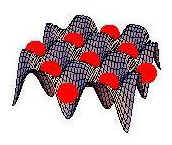Quantum Logic with an Optical Lattice

Quantum computers could potentially calculate much faster than the silicon-based computers of today. Their advantage is that quantum computer bits can remain in two states at once as they perform operations, unlike conventional bits, which must commit to “0” or “1.” The problem for designers is that these quantum bits (qubits) must remain well isolated to preserve their quantum nature, and yet be easily accessible for manipulation by the computer. The 1 February PRL describes a new type of quantum logic gate that might, at least in theory, meet those seemingly contradictory requirements. Researchers suggest that neutral atoms trapped in an optical lattice–a series of potential wells created by the interference of laser beams–might offer advantages over the charged ions and atomic nuclei that are currently used.
One of the most promising ways to build a quantum computer so far has been to trap ultracold charged ions in electric fields and manipulate them using lasers. But since these ions are charged, they interact readily with stray electric fields in the environment and are thus extremely susceptible to decoherence–a loss of quantum character that prevents qubits from remaining in two states. Ivan Deutsch of the University of New Mexico in Albuquerque and Poul Jessen of the University of Arizona in Tucson and their colleagues propose using neutral atoms trapped in an optical lattice for quantum computing. Neutral atoms, they reason, will be less willing to interact with their environment. Moreover, atoms trapped in different wells of an optical lattice hardly influence one another, so a million atoms can potentially be operated upon at once.
To create the optical lattice, the researchers suggest using lasers tuned far from the resonant frequency of the atoms to prevent photon scattering, the main source of decoherence. “The optical lattice is like an egg carton,” says Deutsch, and the atoms are like marbles trapped in each hollow of the carton. According to the team’s proposal, each atom starts out in one of two different internal energy states which represent the logical ones and zeros of the qubits. To get two atoms to “entangle” into a combination of the one and zero states, they have to be moved into the same well, which can be done by changing the lasers’ polarizations. The team then shows how to use another laser to perform a quantum version of the “controlled NOT” operation, which in a classical computer flips the value of one bit based on the value of another bit. In the quantum version, the quantum state of one atom determines its affect on the other. According to quantum computing theory, the complete set of logic operations can be built up from this and a few other basic operations.
Christopher Monroe, of the National Institute of Standards and Technology in Boulder, CO, works with trapped ions and is eager to see researchers try out the new technique in the lab. So far, about a million cesium atoms have been cooled in a two-dimensional optical lattice, but none of the logic operations have been performed on them. If the technique works in practice, Monroe believes, its biggest advantage will be the ability to perform operations in parallel, because many rows of atoms can be moved at once.
–Meher Antia
Meher Antia is a freelance science writer.


